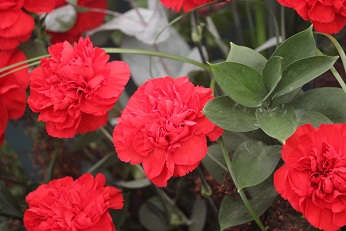Study the different methods of growing and harvesting carnations
Learn
about growing quality carnations (planting, watering, pest &
disease control, fertilizing), different ways of growing them (e.g. as
row crops in soil, in hydroponics, in a greenhouse); and harvesting,
post-harvest treatments, and quality control.
This course is equally
valuable to the home enthusiast and the commercial cut flower grower.

COURSE STRUCTURE
There are eight lessons, as outlined briefly below.
1. Introduction
- Review of the system of plant identification
- Physiology
- Information sources
2. Culture
- Planting
- staking
- mulching
- watering
- feeding
- pruning, etc.
3. Propagation
- Methods of propagating this group of plants
- Propagation of selected varieties
4. Hydroponics
- Hydroponic growing conditions for carnations
- Nutrient requirements
- Suitable hydroponic systems
- Planting out and cultural techniques
- Carnation problems in hydroponics
- Research insights
- Growing in rock wool
- NFT Culture
5. Pest and Disease
- Fungal Diseases (e.g. wilts, rusts, rots)
- Pests (e.g. aphids, bud worms, mites, nematodes
- Bacterial Diseases
- Viruses
- Chemical Use
6. Irrigation
- Water deficiency symptoms
- Water excess symptoms
- Understanding water movement in soil
- Managing soil water loss
- Improving water retention
- Hygroscopic water and gravitational water
- Field capacity
- Plant available water
- Permanent wilting point
- Saturation
- Irrigation infiltration and drainage
- Irrigation timing
- Irrigation system types
- Irrigation system maintenance
- Evapotranspiration
- Controlling drainage
7. Greenhouse Management
- Significance of greenhouse carnation production
- Components of a greenhouse facility
- Greenhouse types
- Controlling an enclosed environment
- Environmental factors (light, temperature, growing media/soil, air composition)
- Managing greenhouse problems
- Carbon dioxide enrichment
- Heating
- Ventilation
- Lighting equipment
- Irrigation and nutrition management in a greenhouse
- Managing pest and disease in a greenhouse
- Scheduling carnation crop production
8. Harvest, Post Harvest and Quality
- When and how to harvest flowers
- Factors that affect flower longevity after harvest
- Chemical treatments
- Other treatments
- Quality control (judging and grading flowers, conditioning for market, packaging)
Course Aims
- Differentiate between different carnation cultivars.
- Describe generic requirements for cultivation of carnations.
- Propagate carnations using different methods.
- Cultivate carnations hydroponically.
- Manage pest and disease problems with carnations.
- Manage water requirements of carnations.
- Cultivate a carnation crop in a greenhouse.
- Manage the harvest and post harvest of carnation crops.
Learn to understand the Diversity within this one Commercially important plant genus
Dianthus is a genus of around 300 species of small herbaceous annual and perennial plants. Many are cultivated a container or rockery plants, and among others are some of the most significant cut flowers used by florists.
Dianthus are classified as follows for exhibitions or competitions.
Selfs –These are flowers that have a single colour
Fancies –These are flowers that have multiple colours such as stripes, blotches, flecks or flakes of a different colour
Picotee Carnations have flowers with a different colour on the margin of the petal
Laced Pinks have an area of different colour in the centre of each petal (sometimes called an eye)
Bicolour Pinks have an area of different colour at the base of each petal; giving the centre of the flower a different colour to the outside.
- A single flower will have one row of five petals in a flower.
- A double flower will have multiple rows or layers of petals; commonly 25 petals or more.
Carnations may be grown in a way that attempts to produce single large flowers on single stems; or alternatively to produce multiple smaller flowers branching off a stem.
Standard Carnations have the side buds removed, to produce a long stem with one terminal flower. Many of the standards grown are bred from an American cultivar called "William Sim".
Spray Carnations are not disbudded. They are grown with many flowers branching from a stem, and are sold as a bunch.
An Alternative Classification
Another way of describing different Dianthus may be according to their growth habit and use; as follows:
- Border Carnations (or Pinks) are grown as border plants; along the edge of a garden bed or pathway. These are usually hardy varieties. Being accessible, they can be useful cut flowers. Flower colours and height can vary, but border carnations normally have double flowers and stems between 40 and 60cm long. May or may not be scented.
- Perpetual Flowering Carnations flower all year. These are half hardy cultivars most commonly grown under glass as cut flowers. Individual flowers can be as much as 10cm diameter and are doubles. Most of the modern cultivars are scented; but early varieties often lack scent.
- Malmaison Carnations are strongly scented cultivars, bred from Dianthus Souvenir de la Malmaison. They are half hardy, grown under glass, bearing large double flowers irregularly throughout the year. Stems can grow to 70cm tall. Malmaison cultivars have been superseded by perpetuals, and as a result many cultivars are no longer available. The main advantage of these cultivars is that they have the largest flowers of all carnations. A major disadvantage is that the flowers are so large that the calyx tends to split easily.
- Micro carnations are cultivars bred to have smaller flowers and be used for posy bowls.
- Alpine Pinks are very hardy alpine plants with a low mat or cushion growth habit. Flowers can be single, semi double or double and are small (1 to 4cm diameter), occurring in warmer months
- Old Fashioned Pinks are very hardy perennials usually forming a compact clump or mound but some having a more open growth habit. Stems can grow up to 45cm long on some varieties. Flowers can reach 3 to 6cm in diameter. Flowering is often only a short period; perhaps a month in early summer each year.
- Modern Pinks are similar to old fashioned pinks, but can have a longer flowering period.